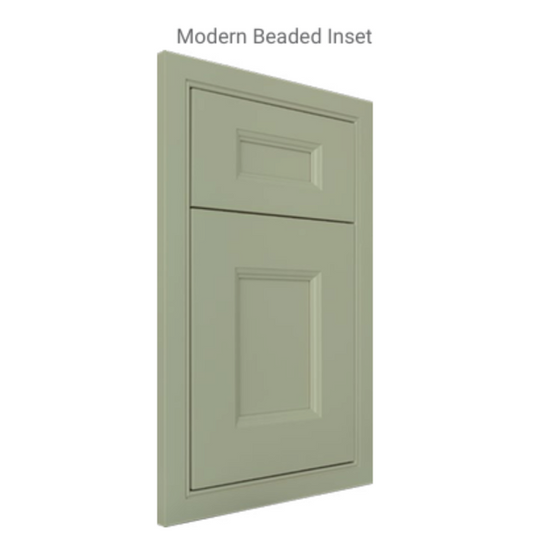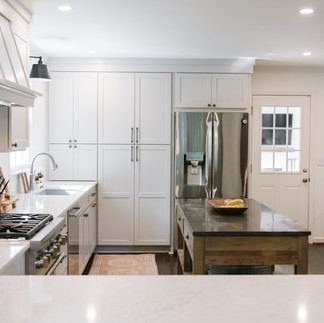Inset vs. Overlay vs. Frameless Cabinetry: Which Style Fits Your Space?
- Dove Studio
- Sep 11, 2024
- 3 min read
If you're considering a kitchen or bath renovation, you've probably noticed how many different choices of cabinet styles, doors, finishes, and frames there are to choose from. An important decision you'll have to make- and one you may not know about - is whether you want inset, overlay, or frameless cabinets.
Here’s a breakdown to help you decide which might suit your style, storage needs, and budget.
Inset Cabinets
Inset cabinets are known for their classic, custom look. Doors and drawers sit flush with the frame, giving a seamless finish that pairs beautifully with traditional, transitional, and farmhouse styles. Designers love them for their elegance, and they’re often seen in high-end, custom installations.
Inset cabinets come with unique customization options, including intricate details like beading and decorative embellishments around the door panel. With endless finishes, stains, and colors available, they offer a highly personalized look.
Check out a few of the different inset door styles that we offer to our clients. You'll notice that we offer flush inset, beaded inset, square beaded inset, and modern inset—each adding a different layer of visual interest.
While inset cabinets elevate the look of a space, they come with some practical considerations. The flush design slightly reduces interior storage space compared to overlay cabinets, and, over time, doors may need minor adjustments to keep them aligned, especially in climates with high humidity.
Despite these trade-offs, many choose inset cabinetry for its timeless appeal and the premium look it brings to kitchens and baths alike.
Pros of inset cabinets
Timeless look, ideal for custom projects.
Sturdy construction
Offered in flush, square, or beaded inset.
Adds a premium feel to your kitchen.
Cons of inset cabinets
Higher price point.
Maintenance may be needed over time.
May reduce storage slightly due to door positioning.
Overlay Cabinets
Overlay cabinets cover the cabinet frame, with either a full or partial overlay. Full overlay doors cover the entire frame, maximizing interior storage, while partial overlay leaves some of the frame exposed, offering a more budget-friendly option.
Overlay cabinets are highly versatile in style and cost, making them ideal for almost any design, Our designers typically use a slab door for more modern and contemporary spaces and opt for a raised, recessed, or flat panel door to create a more traditional or transitional feel.
Pros of overlay cabinets
More cost-effective, especially with partial overlay
Maximizes storage space, especially with full overlay
Adaptable to modern and traditional styles
Cons of overlay cabinets
Partial overlays can show gaps between doors and frames
Doesn’t have the flush, refined look of inset cabinetry
Frameless Cabinets
Frameless cabinetry, often called "European-style," eliminates the face frame, offering a sleek and modern look. Without a frame, the cabinet doors attach directly to the box, maximizing the interior space and providing a full-access layout. This construction style means doors and drawers are slightly wider, which enhances the seamless, minimalist appearance popular in contemporary and Scandinavian designs. Frameless cabinets are often chosen for their clean lines and efficient use of space, especially in smaller kitchens where every inch counts.
Due to the lack of a supportive frame, frameless cabinets require high-quality materials and precise craftsmanship, often making them more expensive than framed options. The construction demands stable and durable materials to ensure stability without the frame's reinforcement, which can raise the price point. While limited to simpler door styles like slab or shaker, frameless cabinets can create a sophisticated, streamlined aesthetic that’s highly appealing in modern interiors.
Pros:
Maximizes interior storage space and accessibility
Sleek, seamless look that suits modern styles
Doors and drawers are usually wider, adding to the aesthetic
Cons:
Typically more expensive than framed overlay cabinets due to structural needs
Requires precise installation to avoid gaps
Which Cabinet Style Is Best for You?
If you’re drawn to timeless elegance and don’t mind a bit of maintenance, inset cabinetry will be worth the investment. Overlay cabinets are an excellent middle ground, offering affordability and versatility in style and function. For those prioritizing a modern, open look and maximum storage, frameless cabinetry might be the perfect choice.
Each option can bring unique flair to your kitchen—so it all depends on the look you love and the practicality you need!
We are an Atlanta-based kitchen and bath design studio specializing in kitchen cabinetry and design. View more projects and learn more about Dove Studio!
.png)










































